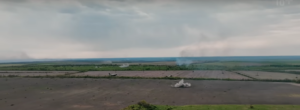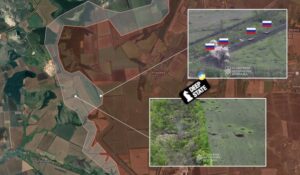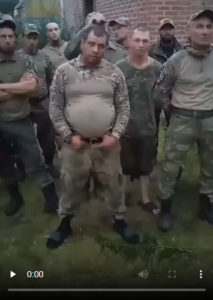3rd Separate Assault Brigade (3 OShBr) is one the most successful brigades in the Ukrainian Army. Since the beginning of May it has advanced about 6-7 kilometres south-west of the outskirts of Bakhmut. This article describes 3 OShBr’s summer campaign to date – how it has achieved its advances and why success over twelve weeks on the eastern battlefields of Ukraine is measured in metres gained and not tens of kilometres.
The ground
3 OShBr has fought in the area roughly eight kilometres southwest of the ruined Bakhmut. The western half of this area is higher ground with numerous small copses. The western boundary is defined by the Siverskyi-Donets Canal and a minor road. The eastern half is flat and open with hedge and tree lines. There are two villages in the area: the larger Klishchiivka immediately southwest of Bakhmut and the smaller Andriivka to the south. Although Andriivka only comprises a small number of dachas, it matters because it sits on a minor road to Bakhmut, used by Russian forces for resupply. Both settlements are in ruins with no civilians. Advancing Russians were able to force the western Siverskyi-Donets Canal but advanced no further. Counter-attacking Ukrainians have faced the mirror problem of advancing east across open fields against strong points and trench lines.

The opposing sides
3 OShBr (fully 3rd Separate Assault Brigade Azov) was formed in March 2022. It was derived from an existing Kyiv-based Azov Territorial Defence unit. The formation was not at full strength in the defensive battles of Northern Command. By the end of 2022, the brigade had been filled out. It now comprised two assault battalions and two mechanised battalions, a tank battalion (trophy T-90s and T-72s), an artillery group, and support elements. A special force Azov unit (Azov SSO Regiment) was amalgamated with the brigade at the beginning of this year. By this period, 3 OShBr was fighting on the Bakhmut front.

Russian forces have comprised one volunteer, one separatist, one regular army, and one airborne (VDV) regiment. 3 OShBr first fought the ad hoc volunteer 72nd Separate Motor Rifle Brigade (72 OMSBr), a ‘brigade’ only in name and subordinate ‘3 Corps’. The formation of 3 Corps was announced with fanfare in the autumn of 2022 (to reinforce the existing 1 and 2 Corps in Donetsk and Luhansk), but it never fully formed due to a lack of volunteers. The soldiers in this formation are actually from Tatarstan and Kurgan. More recently, 3 OShBr has been fighting the Luhansk 14th Territorial Defence ‘Ghost’ Battalion; 57th Motor Rifle Brigade (57 OMBr), and elements of 83rd Airborne Assault Brigade (83 ODShBr). Aside from the Luhansk ‘Ghost’ Battalion, these are overwhelmingly Siberian or Eastern Russians. This overview masks the mixed-up nature of Russian and separatist units, in particular the presence of ‘Z-Storm detachments’ (convicts), used as ‘expendable infantry’. The performance of this mix of units has been poor and is described in later sections.
8-9 May: The departure of Wagner Group – an opportunity is seized
At the beginning of May, Wagner Group boss Yevgeny Prighozin declared his troops would quit Bakhmut, their mission complete. The backdrop was a breakdown in relations, that culminated in the abortive ‘march of justice’ on Moscow and exile of Wagner Group to Belarus. Russian divisions and the coincidence with the 9 May Victory Day parade in Moscow created an opportunity for 3 OShBr to cause embarrassment and swing from the defensive to the offensive.
The Russian formation defending was 72 OMSBr. This comprised of two Alga battalions – ‘Alga’ volunteer battalion from the Republic of Tatarstan, and ’Molot’ volunteer tank battalion from Perm. A ‘Kurgan detachment’ from the Urals was also present. The strength of these units is open to question. Russian ‘brigades’ are routinely battalion-sized, and ‘battalions’ only company-sized. Tanks are never seen in groupings larger than a platoon. The formation was led by an incompetent bully named Venivytin Roman. During the battle he threatened ‘I will shoot you all.’ His poor leadership contributed to the Ukrainian success.
The attack seemed to catch 72 OMSBr by surprise. Over one day, Ukrainian forces were able to advance across a 3 kilometre frontage to a depth of 2,600 metres. Most positions west of the Siverskyi-Donets Canal were overrun. The Russian 6th and 8th companies were completely destroyed, and the brigade reconnaissance was ‘broken’. A reinforcing Wagner 3rd Assault Battalion also suffered heavy losses. This comprised Wagner ‘minders’ and 108 convicts. There were just 12 survivors three days later. None of these unfortunates had ‘papers’ so their existence was basically denied (incidentally highlighting it may never be possible to determine the total Russian dead as it has been State-sanctioned policy to effectively deny the existence of the ‘Zeks’ (convicts); it is only thanks to Prighozin that we know at least 10,000 died in Bakhmut; burning bodies has also become commonplace, filmed by Ukrainian drones).
3 OShBr reported over 60 Russian dead, and 87 wounded. Five Russians were captured and paraded on camera. The Russian response to the setback was standard: ‘the enemy fired at our positions 479 times with different systems and different artillery. There were 4 air raids.’ However, 3 OShBr could not be dislodged. Prighozin complained loudly over the rout of 72 OMSBr which had now exposed his southern flank.

After the action, four Russian officers from72 OMSBr posted a YouTube video bitterly complaining over the ‘criminal orders’ of the commander Venivytin Roman. The English transcript of their Philippic is ten pages long and too involved to repeat. In summary, Venivytin was using the soldiery – in particular the convicts – as ‘expendable infantry’ to plug gaps. There was no coordination, no support, and not even resupply, as if he did not expect them to live, conveniently removing the need to resupply at all. All the while, Venivytin was nowhere near the front line: he was 25 kilometres away in Troits’ke, relaying intemperate and suicidal orders to the units by HF radio. Drunkenness and ‘smoking’ (drugs) were alleged. Russian combat orders are supposed to be drafted in hard copy and signed (so that insubordinate behaviour can later be charged with documentary proof). Venivytin was not even bothering to do that.

18-19 May: Another land grab is made
Ten days later, 3 OShBr made another land grab. This was a two-phase operation. On day one, 1st Assault and 1st Mechanised Battalions succeeded in advancing across a 2,000-metre frontage to a depth of 700 metres. Four prisoners were taken and Ukrainian forces reported ‘at least 50 ‘200s’ and up to a hundred ‘300s’’ [50 KIA/100 WIA].
The following day, 2nd Assault Battalion attacked. An advance across a 1,730 metre frontage to a depth of 700 metre was claimed, although this may have been repeat reporting of ground gained on the first day. Commander 3 OShBr summarised the actions with these words: ‘These operations take place in a cascade, i.e. in an incremental manner. We are trying to feel the enemy’s weak spots and gradually, step by step, we are trying to squeeze him out, occupying advantageous positions for us.’
7 June: A third land grab
Almost three weeks later, 2nd Assault Battalion launched another surprise attack and managed to advance across a 1,800-metre frontage to a depth of 1,200 metres. By this point, the broken72 OMSBr had been withdrawn, and the Russian line was now being held by 57 OMBr, an outfit from Eastern Russia, reinforced by more ‘Storm-Z detachments’ or convicts. This unit fared no better. A combination of poor leadership and low morale seems to have triggered another rout. The Ukrainians reported 30 killed and 40 wounded. Whether or not related, over this period, a group of convicts mutinied and posted a YouTube video denouncing their treatment as ‘meat’.

25th June: Russian forces completely cleared west of the Siverskyi-Donets Canal area
Just over two weeks later, an exultant Lieutenant Colonel Andriy Biletskyi (commander of the amalgamated SSO Azov Regiment within 3 OSHBr) reported the entire west bank of the Siverksyi Donets Canal had been cleared of Russian forces following the comprehensive defeat of the 3rd Battalion of 57 OMBr by 1st Mechanised Battalion. The Ukrainians reported 30 killed, 50 wounded, and ‘dozens of prisoners’ (but no video evidence).
11 July: The first Russian paratrooper strongpoint is taken
After a pause, it was the turn of 2nd Assault Battalion to attack again. Successive collapses of defending units in this sector eventually led to the deployment of elements from 83 ODShBr to stiffen the line. These were paratroopers from Eastern Military District. The Ukrainian objective was, in fact, a paratrooper strongpoint. 2nd Assault Battalion succeeded in over-running the position and capturing ten Russian prisoners (shown on video). The attack effectively moved the front line another 1,000 metres forward leaving Ukrainian forces in a more advantageous position.
25 July – Russian forces driven from Andriivka
For several weeks, Klishchiivka had been a contested (and totally destroyed) settlement. Russian forces could not cede here because the next town is Bakhmut. The Russian obsession with mounting attacks on Ukrainian soldiers lodged in the south of the village was leaving flanks dangerously exposed. 3 OShBr decided to take advantage of this situation and assault the thinly defended Andriivka further south.
The Russians responded with an unsupported and poorly coordinated tank counter-attack that was defeated by kamikaze drones (Russian tank crews continue to be restricted by not fit-for-purpose or non-functioning radios; they fall back on Motorola walkie-talkies and thus reveal locations and intentions). Attempts to reinforce with infantry were similarly broken up with cluster munitions.

‘We see a puff pastry of units that are simply shoved into unprepared trench lines. There are so many people that every 10-15 meters someone hides under the remnants of greenery, in holes, without even preparing for any kind of defence!…COMPLETE superiority of the enemy in drones, working non-stop day and night…’
‘They [the reinforcements] run away shamefully!! Had to shoot in the air to stop the flight,’ he complained, adding, ‘We have almost 20 wounded and 29 dead.’ On 28 July, against the backdrop of this Russian disarray, a further 1,200-metre advance was made. Another eight paratroopers were captured and a number were killed and wounded.
As the situation deteriorated on the ground, the Russian commander, Major General Vladimir Seliverstov, began raising uncomfortable questions and demanding more resources. As in the case of General Popov, he was fired on the spot (reportedly, Tula governor Dyumin has since personally interceded with the presidential administration on Seliverstov’s behalf, and the general is back in his job; if the report is true, which it appears to be, it offers another example of the dysfunctional relationships in the Russian government with powerful individuals in the Kremlin – in this case Anton Vaino, Putin’s chief of staff– overruling the Ministry of Defence).
The expansion of the Ukrainian salient has sucked in more units on both sides. 3 OShBr has pushed further south with an operation near Kurdiumivka. This effort yielded positive results, with the assaulting troops clearing multiple tree lines and forcing Russian troops to abandon trenches and fortifications. Russian forces have now reportedly withdrawn east of the railway line that runs to Bakhmut and abandoned Andriivka.
At the time of writing, the area southwest of Bakhmut remains contested in what is commonly referred to as a ‘grey zone’, or no-man’s land.
Concluding thoughts
From the beginning of May to the present, 3 OShBr mounted six deliberate operations southwest of Bakhmut. They all succeeded. These were day, infantry-led assaults, in company and platoon strength against strong points and trench lines. Tanks were used in ones and twos to lead in assaults and to provoke flight. Objectives were ‘prepped’ with artillery and rocket fire. Over the twelve weeks, 3 OShBr inflicted a three-figure number of casualties on Russian forces while only suffering light casualties. Around 20 prisoners were taken (with video evidence), but the true number will be higher. Russian equipment and ammunition storage sites were destroyed. Four units were defeated and a Russian major general was sacked and then apparently re-instated.
Notwithstanding this success, there is the unavoidable question of tempo. The explanations for 3OShBr’s slow advance do not lie in mine belts and defensive obstacles which are slowing down the Ukrainian counter-offensive on the Zaphorizhzhia front. Russian forces never built these in this sector, as they were advancing with the intent to capture Bakhmut and the surrounding area. The three principal reasons for the slow tempo are:
- Casualty aversion: 3 OShBr has been pursuing a deliberate policy of re-capturing ground, incurring no or few casualties. This goal has been achieved but has reduced the tempo of Ukrainian operations.
- Soldier weights: In an infantry war, an assault can only advance as far as a soldier of average fitness can fight before exhaustion sets in.
- Artillery: Artillery (and rocket) fire is still accounting for four in five casualties. This may explain why of 100 Ukrainian soldiers wounded within 3 miles of the front line, 36% are very seriously wounded (shrapnel wounds). After capturing a Russian strongpoint or trench line, Ukrainian troops perforce must remain in place as the standard Russian response is to bombard the lost positions. In one recent case, Ukrainian soldiers had to share the trenches with the Russian dead which could not be moved (not least because the departing Russians, who not uncommonly abandon their dead, had booby-trapped the corpses). The only option was to cover the corpses with plastic sheets which due to the cramped conditions were used as ‘soft’ seats, while smoking heavily to disguise the smells. A Ukrainian soldier asked whether he was not afraid one of bodies might suddenly detonate, replied; ‘Everything is detonating here.’
This methodical approach has worked for 3 OShBr, but it carries an important penalty: breakthrough is not achieved. The defender is afforded 2-3 week windows to reinforce, re-build defences, and prepare for the next Ukrainian push. This has been the pattern for the last three months. Emphatically, this war is not the coming of the tank Antichrist – the tank a platform with ‘no future’ – as some commentary suggests. On the contrary: every day is a reminder that until someone rediscovers brigade-level, mobile, all arms, armoured warfare, the grinding penny-packet infantry attrition will continue.
Sergio Miller
Sergio Miller is a retired British Army Intelligence Corps officer. He was a regular contributor and book reviewer forBritish Army Review. He is the author of a two-part history of the Vietnam War (Osprey/Bloomsbury) and is currently drafting a history of the Russian invasion of Ukraine.





